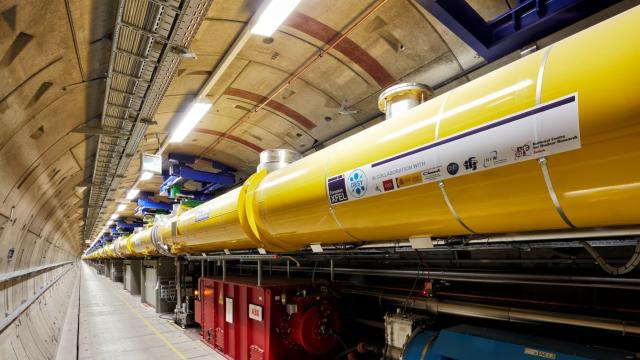Even if you haven’t seen any James Bond films, you’re probably aware that the space laser battle depicted in Moonraker ranks among the stupidest scenes in the franchise’s history. But there’s a new laser gun in town that’s actually good and opening up for business. It is not a weapon.
Image: European XFEL/Heiner Müller-Elsner
The European X-ray Free Electron Laser (XFEL) will begin operating in September, and it will shoot 27,000 laser pulses per second, 200 times more per second than the next highest-performing gun in California. Scientists don’t often use laser guns to shoot astronauts, and only sometimes use them to direct PowerPoints. Instead, think of the European XFEL as an incredibly high-speed and detailed movie camera.
“That sucks, and is not what lasers do in movies,” is a thought you might have. But bear with me, the European XFEL is actually kind of cool.
The €1.5 billion ($2.3 billion) laser replaces its predecessor, FLASH, in Germany. According to the experiment’s website, the system contains 768 cavities on a 1.7km-long pipe with alternating electromagnetic fields, sending the electrons back and forth in a wobble. Changing an electron’s direction causes it to shoot light forward, but then that light (which moves a little bit faster than the high-energy electrons), also influences how the electron moves and continues to radiate, in turn creating the X-ray pulses. The experiment dumps the electrons and keeps the X-rays.
A lot of high-energy, tiny X-ray pulses means the device can be used to take detailed pictures of cells or molecules such as proteins down to their atoms. They can also capture really fast phenomena, such as chemical bonds forming, according to the European XFEL website. The radiation can also be used to study individual atoms or molecules under extreme conditions. You may have seen some of the work done using synchrotron radiation — that’s the kind of stuff scientists might want to do with the European XFEL. This can help researchers understand the most basic physics, or help them develop new drugs based on the best possible knowledge of cells and their functions.
There are other X-ray lasers in use, and they’re in high demand by scientists, but they don’t reach nearly the performance of the newest one; one in California pulses 120 times per second, while another in Japan runs at 60 pulses per second, according to a press release on Phys.org. But other advanced laser guns came online recently or will open soon, reports Nature, including one in Switzerland and another in South Korea.
Germany has been celebrating — lasers are shining over the nearby city of Hamburg to herald the experiment’s arrival.
But as good as XFEL is, it won’t reign supreme for long, writes Nature. The SLAC National Accelerator Laboratory will open a facility that can pulse a million times per second in the 2020s.
